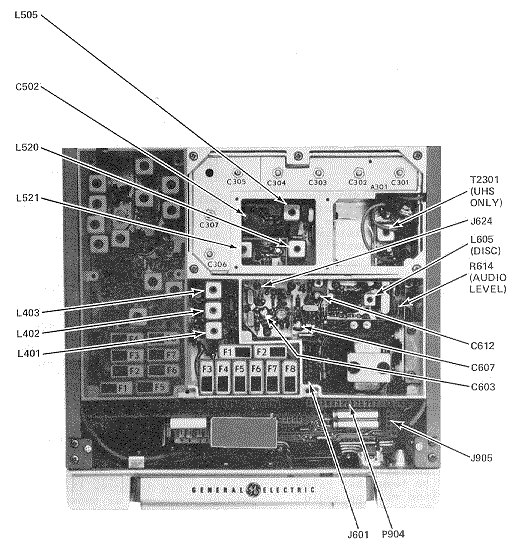MASTR
II VHF Receiver Re-Alignment
ICOM Adjustment
 Before
you align the receiver, you need to net you receiver ICOM. ICOM frequency
adjustments are made by attaching a frequency counter at the junction of
C417 and C415 (shown in the picture to the right, top right corner) which
is located to the right of L403. In a VHF receiver the frequency you want
to adjust the ICOM to is your receive frequency less 11.2 MHz which should
be 9 times the crystal frequency.
Before
you align the receiver, you need to net you receiver ICOM. ICOM frequency
adjustments are made by attaching a frequency counter at the junction of
C417 and C415 (shown in the picture to the right, top right corner) which
is located to the right of L403. In a VHF receiver the frequency you want
to adjust the ICOM to is your receive frequency less 11.2 MHz which should
be 9 times the crystal frequency.
An example, if you wished to receive on 147.99 MHz, subtract
11.2 MHz (the IF frequency) which yields 136.79 MHz. Adjust the ICOM for
a frequency reading measured at the indicated test point. The crystal
frequency should be the receive frequency less 11.2 divided by 9.
For a receive frequency of 147.99 MHz the crystal frequency should be 15.19888
MHz.
To properly adjust the ICOM frequency, you need to
factor
in the room temperature and be sure the receiver is at room temperature.
VHF Receiver Re-Alignment

All measurements are against ground (pin 8 of J-601. Use
an analog meter or VTVM for all measurements.

|
Adjust L401 for maximum meter
reading at J601-3. |

|
Preset L402 and L403 to a position
similar to L401, then preset C306 and C307 fully counter-clockwise. |

|
Adjust L402 and L403 for maximum
meter reading on J601-4, then re-tune L401, L402 and L403. |
| |
Carefully adjust C306 for minimum
then adjust C307 for maximum. |

|
Attach your meter to J601-1 and
apply an on frequency signal to the antenna jack. Adjust the signal strength
as needed during the alignment. |

|
Adjust C501, C301, C302, C303,
C304, C305 (and T2301 if present) for maximum meter reading. Reduce your
signal strength and re-tune slightly. |

|
C306 and C307 may be adjusted
no more than a quarter turn for best quieting. |
This site, its contents, and look & feel are Copyrighted©
2001 Kevin Custer W3KKC
All Rights Reserved.
 Before
you align the receiver, you need to net you receiver ICOM. ICOM frequency
adjustments are made by attaching a frequency counter at the junction of
C417 and C415 (shown in the picture to the right, top right corner) which
is located to the right of L403. In a VHF receiver the frequency you want
to adjust the ICOM to is your receive frequency less 11.2 MHz which should
be 9 times the crystal frequency.
Before
you align the receiver, you need to net you receiver ICOM. ICOM frequency
adjustments are made by attaching a frequency counter at the junction of
C417 and C415 (shown in the picture to the right, top right corner) which
is located to the right of L403. In a VHF receiver the frequency you want
to adjust the ICOM to is your receive frequency less 11.2 MHz which should
be 9 times the crystal frequency.
